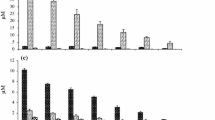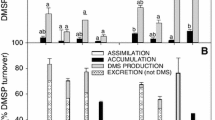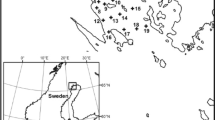Abstract
We investigated the influence of bacteria and metazooplankton on the production of dimethylsulfoniopropionate (DMSP) and dimethylsulfide (DMS) during blooms of Emiliania huxleyi (Lohmann) Hay and Mohler in seawater mesocosms. The phytoplankton succession was marked by the rapid collapse of an initial Skeletonema costatum (Greville) Cleve bloom followed by a small E. huxleyi bloom. The collapse of the diatom bloom was accompanied by an increase in concentrations of dissolved DMSP (DMSPd) and bacterial abundance and activity (as determined by the thymidine incorporation technique). The increase in bacterial activity was followed by a rapid decrease in DMSPd concentrations which remained low for the rest of the experiment, even during the subsequent collapse of the E. huxleyi blooms. The absence of DMSPd and DMS peaks during the declining phase of the E. huxleyi blooms was attributed to the high bacterial activity prevailing at that time. The influence of metazooplankton grazing on DMSP and DMS production was investigated by adding moderate (24 mg dry weight m-3) and high (520 mg dry weight m-3) concentrations of Copepodite Stage V and adults of Calanus finmarchicus to two of four filtered (200 μm mesh net) enclosures during the E. huxleyi blooms. The addition of C. finmarchicus, even in high concentrations, had no apparent effect on the dynamics of E. huxleyi, suggesting that the copepods were not grazing significantly on nanophytoplankton. The addition of copepods in high concentrations favored an accumulation of chlorophyll a and particulate DMSP. These results suggest that copepods were preying on the herbivorous microzooplankton which, in turn, was controlling the biomass of nanophytoplankton. DMS production was also enhanced in the enclosure with maximum metazooplankton biomass, suggesting that the grazing of C. finmarchicus on microzooplankton containing DMSP may contribute to DMS production. These results provide strong support to the emerging idea that bacteria and metazooplankton grazing play a dominant role in determining the timing and magnitude of DMS pulses following phytoplankton blooms.
Similar content being viewed by others
References
Ackleson S, Balch WM, Holigan PM (1988) White waters of the Gulf of Maine. Oceanography, Wash 1: 18–22
Ackman RG, Tocher CS, McLachlan J (1986) Occurrence of dimethyl β-propiothetin in marine phytoplankton. J Fish Res Bd Can 23: 357–362
Balch M, Holligan PM, Kilpatrick KA (1992) Calcification, photosynthesis and growth of the bloom-forming coccolithophore, Emiliania huxleyi. Contin Shelf Res 12: 1353–1374
Båmstedt U, Håkanson JL, Brenner-Larsen J, Björnsen PK, Geertz-Hansen O, Tiselius P (1990) Copepod nutritional condition and pelagic production during autumn in Kosterfjorden, western Sweden. Mar Biol 104: 197–208
Belviso S, Buat-Ménard P, Putaut J-P, Nguyen BC, Claustre H, Neveux J (1993) Size distribution of dimethylsulfoniopropionate (DMSP) in areas of the tropical northeastern Atlantic Ocean and the Mediterranean Sea. Mar Chem 44: 55–71
Belviso S, Kim S-K, Rassoulzadegan F, Krajka B, Nguyen BC, Mihalopoulos N, Buat-Ménard P (1990) Production of dimethylsulfonium propionate (DMSP) and dimethylsulfide (DMS) by a microbial food web. Limnol Oceanogr 35: 1810–1821
Blom G, Otterå H, Svåsand T, Kristiansen TS, Serigstad B (1991) The relationship between feeding conditions and production of cod fry (Gadus morhua) in a semi-enclosed marine ecosystem in western Norway, illustrated by use of a consumption model. ICES mar Sci Symp 192: 176–189
Bratbak G, Egge JK, Heldal M (1993) Viral mortality of the marine alga Emiliania huxleyi (Haptophyceae) and termination of algal blooms. Mar Ecol Prog Ser 93: 39–48
Bratbak G, Levasseur M, Michaud S, Fernandez E, Cantin G, Heimdal B, Heldal M (1995) Field assessment of the potential virus/DMS connection during Emiliania huxleyi blooms. Mar Ecol Prog Ser 128: 133–142
Brown CW, Yoder JA (1984a) Distribution of coccolithophore blooms in the western North Atlantic Ocean. Contin Shelf Res 14: 175–197
Brown CW, Yoder JA (1994b) Coccolithophorid blooms in the global ocean. J Geophys Res 99: 7467–7482
Challenger F, Simpson MI (1948) Studies on biological methylation. Part XII. A precursor of the dimethylsulfide evolved by Polysiphonia fastigiata. Dimethyl-2-carboxyethylsulphonium hydroxide and its salts. J chem Soc 3: 1591–1597
Cole JJ, Findlay S, Pace ML (1988) Bacterial production in fresh and saltwater ecosystems: a cross-system overview. Mar Ecol Prog Ser 43: 1–10
Conway HL, Harrison PJ (1977) Marine diatoms grown in chemostats under silicate and ammonium limitation. IV. Transient response of Chaetoceros debilis, Skeletonema costatum, and Thalassiosira gravida to a single addition of a limiting nutrient. Mar Biol 43: 33–43
Dacey JWH, Wakeham SG (1986) Oceanic dimethylsulfide: production during zooplankton grazing on phytoplankton. Science, NY 233: 1314–1316
Falkowski PG, Kim Y, Kolber Z, Wilson C, Wirick C, Cess R (1992) Natural versus anthropogenic factors affecting low-level cloud albedo over the North Atlantic. Science, NY 256: 1311–1313
Fuhrman JA, Azam F (1982) Thymidine incorporation as a measure of heterotrophic bacterioplankton production in marine surface waters: evaluation and field results. Mar Biol 66: 109–120
Gabric A, Murray N, Stone L, Kohl M (1993) Modelling the production of dimethylsulfide during a phytoplankton bloom. J geophys Res 98: 22,805–22,816
Gröne T, Kirst GO (1992) The effect of nitrogen deficiency, methionine and inhibitors of methionine metabolism on the DMSP contents of Tetraselmis subcordiformis (Stein). Mar Biol 112: 497–503
Hansen FC (1995) Trophic interactions between zooplankton and Phaeocystis cf. globosa. Helgoländer Meeresunters 49: 238–293
Hansen FC, Reckermann M, Klein-Breteler WCM, Riegman R (1993) Phaeocystis blooming enhanced by copepod predation on protozoa: evidence from incubation experiments. Mar Ecol Prog Ser 102: 51–57
Harris GP (1980) Temporal and spatial scales in phytoplankton ecology. Mechanisms, methods, models and management. Can J Fish aquat Sciences 37: 877–900
Harris RP (1994) Zooplankton grazing on the coccolithophore Emiliania huxleyi and its role in inorganic carbon flux. Mar Biol 119: 431–439
Holligan PM, Fernandez E, Aiken J, Balch WM, Boyd P, Burkill PH, Finch M, Grooms SB, Malin G, Muller K, Purdie DA, Robinson C, Trees CC, Turner SM, van der Wal P (1993) A biogeographic study of the coccolithophore, Emiliania huxleyi, in the North Atlantic. Global biogeochem Cycles 7: 879–900
Holligan PM, Turner SM, Liss PS (1987) Measurements of dimethyl sulphide in frontal regions. Contin Shelf Res 7: 213–224
Iverson RL, Nearhoof FL, Andreae MO (1989) Production of dimethylsulfonium propionate and dimethylsulfide by phytoplankton in estuaries and coastal waters. Limnol Oceanogr 34: 53–67
Keller MD, Bellows WK, Guillard RRL (1989a) Dimethyl sulfide production in marine phytoplankton. In: Saltzmann ES, Cooper EM (eds) Biogenic sulfur in the environment. ACS Symposium Series No. 393, American Chemical Society, Washington, DC, pp 167–182
Keller MD, Bellows WK, Guillard RRL (1989b) Dimethylsulfide production in marine phytoplankton: an additional impact of unusual blooms. In: Cosper EM, Bricelj VM, Carpenter EJ (eds) Novel phytoplankton blooms. Springer-Verlag, Berlin, pp 101–115
Kiene RP (1992) Dynamics of dimethyl sulfide and dimethylsulfoniopropionate in oceanic water samples. Mar Chem 37: 29–52
Kiene RP, Service SK (1991) Decomposition of disolved DMSP and DMS in estuarine waters: dependence on temperature and substrate concentration. Mar Ecol Prog Ser 76: 1–11
Klein-Breteler WCM, Schogt N, van der Meer J (1994) The duration of copepod life stages estimated from stage-frequency data. J Plankton Res 16: 1039–1057
Kleppel GS (1993) On the diets of calanoid copepods. Mar Ecol Prog Ser 99: 183–195
Kwint RLJ, Kramer KJM, Baart AC, Verhagen HLM (1993) The production of DMS by a plankton community: a mesocosm experiment. In: Restelli G, Angeletti G (eds) Dimethylsulphide: oceans, atmosphere and climate. Int Symp Proc Belgirate. Kluwer Academic Publications, Dordrecht, pp 53–62
Leck C, Bågander LE (1988) Determination of reduced sulfur compounds in aqueous solutions using gas chromatography flame photometric detection. Analyt Chem 60: 1680–1683
Leck CL, Larsson U, Bågander LE, Johansson S, Hajdu S (1990) Dimethyl sulfide in the Baltic Sea: annual variability in relation to biological activity. J geophys Res 95: 3353–3363
Ledyard K, Dacey JWH (1994) Dimethylsulfide production from dimethylsulfoniopropionate by a marine bacterium. Mar Ecol Prog Ser 110: 95–103
Levasseur M, Bonneau E, Keller M, Bellow W (1994) Oceanographic basis of (Gadua morhua) cod a DMS-related Atlantic fisheries problem: blackberry feed. Can J Fish aquat Sciences 51: 881–889
Malin G, Turner SM, Liss PS (1992) Sulfur: the plankton/climate connection. J Phycol 28: 590–597
Malin G, Turner SM, Liss P, Holligan P, Harbour D (1993) Dimethylsulphide and dimethylsulphoniopropionate in the Northeast Atlantic during the summer coccolithophore bloom. Deep-Sea Res 40: 1487–1508
Matrai PA, Keller MD (1993) Dimethylsulfide in a large-scale coccolithophore bloom in the Gulf of Maine. Contin Shelf Res 13: 831–843
Matrai PA, Keller MD (1994) Total organic sulfur and dimethylsulfoniopropionate in marine phytoplankton: intracellular variations. Mar Biol 119: 61–68
Nejstgaard JC, Båmastedt U, Bagøien E, Solberg PT (1985) Algal constraints on copepod grazing. Growth state, toxicity, cell size, and season as regulating factors. ICES J mar Sci 52: 347–357
Nejstgaard JC, White H, van der Wal P, Jacobsen A (1994) Copepod grazing during a mesocosm study of an Emiliania huxleyi (Prymnesiophyceae) bloom. Sarsia 79: 369–378
Nguyen B, Belviso S, Mihalopoulos N, Gostan J, Nival P (1988) Dimethyl sulfide production during natural phytoplankton blooms. Mar Chem 24: 133–141
Ohman MD, Runge JA (1994) Sustained fecundity when phytoplankton resources are in short supply: omnivory by Calanus finmarchicus in the Gulf of St. Lawrence. Limnol Oceanogr 39: 21–36
Parsons TR, Maita Y, Lalli CM (1984) A manual of chemical and biological methods for seawater analysis. Pergamon Press, Oxford
Porter KG, Feig YS (1980) The use of DAPI for identifying and counting aquatic microflora. Limnol Oceanogr 25: 943–948
Stefels J, van Boekel WHM (1993) Production of DMS from dissolved DMSP in axenic cultures of the marine phytoplankton species Phaeocystis sp. Mar Ecol Prog Ser 97: 11–18
Stoecker DK, Capuzzo JM (1990) Predation on protozoa: its importance to zooplankton. J Plankton Res 12: 891–908
Turner SM, Malin G, Liss PS, Harbour DS, Holligan PM (1988) The seasonal variation of dimethyl sulfide and dimethylsulfoniopropionate concentrations in near-shore waters. Limnol Oceanogr 33: 364–375
Utermöhl H (1931) Neue Wege in der quantitativen Erfassung des Planktons (mit besonderer Berücksichtigung des Ultraplanktons). Verh int Verein theor angew Limnol 5: 567–596
Vairavamurthy A, Andreae MO, Iverson RL (1985) Biosynthesis of dimethylsulfide and dimethyl-propiothetin by Hymenomonas carterae in relation to sulfur source and salinity variations. Limnol Oceanogr 30: 59–70
Widdows J (1991) Physiological ecology of mussel larvae. Aquaculture, Amsterdam 94: 147–163
Wolfe GV, Kiene RP (1993) Radioisotope and chemical inhibitor measurements of dimethyl sulfide consumption rates and kinetics in estuarine waters. Mar Ecol Prog Ser 99: 261–269
Wolfe GV, Sherr EB, Sherr BF (1994) Release and consumption of DMSP from Emiliania huxleyi during grazing by Oxyrrhis marina. Mar Ecol Prog Ser 111: 111–119
Author information
Authors and Affiliations
Additional information
Communicated by R. J. Thompson, St. John's
Rights and permissions
About this article
Cite this article
Levasseur, M., Michaud, S., Egge, J. et al. Production of DMSP and DMS during a mesocosm study of an Emiliania huxleyi bloom: influence of bacteria and Calanus finmarchicus grazing. Marine Biology 126, 609–618 (1996). https://doi.org/10.1007/BF00351328
Received:
Accepted:
Issue Date:
DOI: https://doi.org/10.1007/BF00351328




